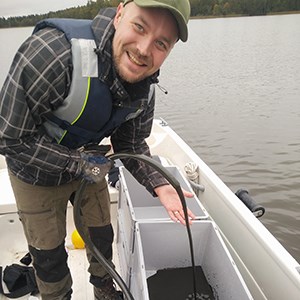When lake ecosystems work well, water quality is good. This allows us humans to use the resources that water constitutes. We can fetch drinking water from clean water bodies, use it to go for a swim, or catch fish for dinner. Oskar Agstam-Norlin has written a doctoral thesis that shows how the lake's ecosystem can be restored in a lasting and efficient way.
What new knowledge is presented in the doctoral thesis
When the water quality in a lake is so poor that the water cannot be used, there are ways to speed up recovery. During his time as a doctoral student at the Department of Aquatic Sciences and Assessment, SLU, Oskar Agstam-Norlin has developed new knowledge of how lake recovery can be accelerated through restoration methods.
Ecosystems in lakes
Numerous organisms, such as phytoplankton, live in our waterbodies. The organisms ensure that energy and nutrients are cycled in lakes. In some lakes, this ecosystem has deteriorated due an excess of phosphorus. High levels of phosphorus leads to eutrophication and nourishes i.e. phytoplankton growth leading to unwanted algal blooms. In-lake drivers of eutrophication can be stopped with the help of aluminum, which inactivates the excess phosphorus in sediments. Treatment using aluminum has varying effects on different types of lakes, which Oskar Agstam-Norlin has been able to demonstrate through his research. He has also been able to show the factors that underlie this variation.
Restoration method for nutrient rich lakes
For several decades, lake restoration has taken place through a so-called aluminum treatment procedure. This involves adding aluminum to lake water or lake sediment to stop the release of sediment phosphorus and thereby reduce eutrophication. In addition to better understanding of how aluminum can reduce eutrophication, Oskar Agstam-Norlin also contributes through his thesis with knowledge of a sometimes more effective application procedure for aluminum treatment. There, the aluminum mineral is added directly into the lake's sediment matrix instead of being added to the body of water. Oskar Agstam-Norlin has also developed a model for dosing aluminum as well as possible during restoration, in those cases where aluminum is added directly to the sediment.
Did you find anything in your research that you did not expect?
- We had our hypotheses, says Oskar Agstam-Norlin. But the most important message for successful lake restoration is that one must understand that lakes are very different and therefore need to be considered differently in terms of restoration method. It is important to always have an understanding of the unique properties of lakes and the potentially available phosphorus that you want to remove or inactivate, with for example aluminum application procedures.
How will you continue to work on this research in the future?
- I will continue in the same subject area, there are many question marks to straighten out in order to optimize sea restoration.
